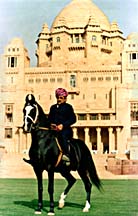Marwari
N/A
Fri, 18th April, 2025 - 8:34 pm GMT
Sponsor Ads:

Alternative Name
N/ABasic Info
The modern Marwari has an average height of 14 hands to 15.2 hands. Predominant colors are bay, chestnut, brown, palomino, piebald, and skewbald.
Health
N/AHabitat
N/ABehavior
Marwaris are an extremely sturdy breed, able to take thirst and heat in stride because of their thin skin. They are hardy enough to subsist on the small rations available in their desert environment, and rarely need shoes. The Marwari have slightly less slant to their shoulder bones enabling them to more easily extract their legs from deep sand. The angle of the bone prevents the Marwari from striding out to the fullest, thus diminishing their speed. The resulting action of the legs however, makes the Marwari a very comfortable horse to ride. The ears of the Marwari have a distinct inwards curve with the tips sometime touching. This is thought to have come from the introduction of Arab blood into the breed. In spite of a compact body, nature provided the Marwari with longer limbs which keep the horse's underside away from the scorching sand of the desert.Origin
Marwar region of IndiaHistory
The Marwari horse is native to the Marwar region of India, and its origins are entwined with local folklore. According to Shri Mahant Baba Balak Dasji Maharaj, the head Priest of the Monastery at Kalabar, and a breeder of Marwari horses, the breed can be traced to a period, "when the ocean was churned to extract nectar for the Gods…a period when horses had wings." The Rathores, a warrior clan of the Raiputs, were driven from their kingdom of Kannaju around the 12th century. The land in which they resettled was known as "Maru Pradesh" meaning the land of death. As the name implies, this was a desolate and harsh land that required an equally rugged horse. The native Marwari Horse proved particularly well suited for both the desert environment and its role as a battle horse for the Rathore cavalry. During the Middle Ages, the principal occupation of the Rathores of Marwar was breeding Marwari Horses. The Raiputs fielded a cavalry consisting of more than 50,000 horses under the reign of Mogul emperor Akbar. The Marwari's homing instinct helped save many a rider's life. They were famous for bringing back riders who became lost in the desert. The Marwari breed has long been noted for having exceptional hearing. This enabled the Marwari to catch sounds from further away than most breeds, allowing both horse and rider early warning of impending danger. The brave Raiput did not always fight solely for land. They went into battle believing that there was no better way to die than on the field. It was on such occasions that the Marwari would become one with their masters. No one could separate the blood that lay clotted together in the sand. There were only three ways a Marwari cavalry horse left a battlefield: one was when if he was victorious, another was when he carried his wounded master to safety, and the last was when he was eaten by vultures after laying down his life for his Master.Common Foods
grassSponsor Ads:
The power of accurate observation is commonly called cynicism by those who have not got it. --George Bernard Shaw
Marwari
Coded by: BGID® | ALL RIGHTS RESERVED Copyright © 2000-2025
Disclaimer | Privacy | Report Errors / Contact | Credits


 Preparing For China. China is growing their military. China Military Technology - can it keep up with the US?
Preparing For China. China is growing their military. China Military Technology - can it keep up with the US?  versus
versus 

 versus
versus 
 This Thread is about the North Korean Military itself - the kind of army, navy, and air force they have.
This Thread is about the North Korean Military itself - the kind of army, navy, and air force they have. 
 versus
versus 
 versus
versus  versus
versus